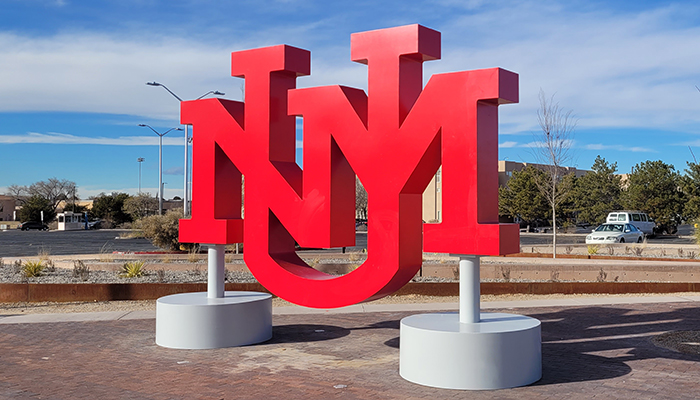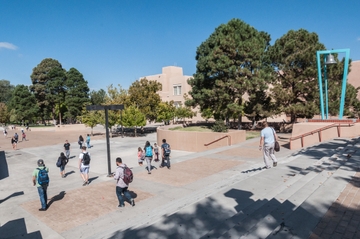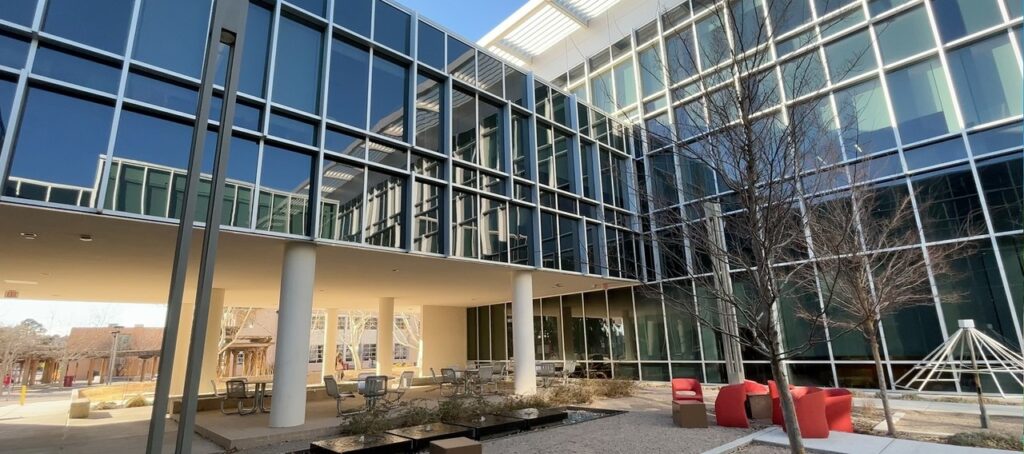The design of indoor and outdoor spaces has the power to shape not just how we use an area, but also how we feel about it. Design can help inform whether someone wants to meet friends or move through an area quickly. It can even discourage crime.
Crime Prevention Through Environmental Design (CPTED) is a multi-disciplinary approach to crime prevention that uses urban and architectural design and the management of built and natural environments to help deter offender decisions that precede crime and foster feelings of safety.
The University of New Mexico’s Planning, Design, and Construction Department has utilized CPTED principles in its building and landscape designs for the past several years, according to Amy Coburn, University Architect. Visitors can observe the principles in areas like Johnson Center, Smith Plaza, the Physics Astronomy and Interdisciplinary Science (PAÍS) building, and the new Campus Gateway at Central and Girard.
“UNM applies CPTED principles in developing our built environment to reduce crime and the fear of crime,” Coburn said. “The CPTED principles include natural access control, natural surveillance, territory control, and other design practices, which, when applied to campus improvement projects, create a visibly safe, clean, and accessible environment.”
A recent study from Texas A&M University found that a neighborhood’s overall sense of cleanliness and the visual qualities of buildings can provide visual cues of care that are associated with lower rates of property and violent crime.

This sense of managed environment is integral to ensuring campus visitors feel safe and potential offenders are discouraged from making criminal choices on campus. The recent demolition of wall structures at the corner of Central Avenue and Girard Boulevard—along with the addition of unobstructive landscaping, an open walkway, and a 3D UNM monogram statue—helped visually reclaim a space that had become associated with public safety concerns.
Aaron Zahm, principal landscape architect with MRWM Landscape Architects, has helped design several projects at UNM including the redevelopment of Smith Plaza and the Campus Gateway. He said there is another key element in the design of safe areas––people.
“One of the big principles of CPTED is activating a space so there is natural surveillance and activity there that puts ownership and eyes on the area so that people who want to do bad things don’t feel comfortable doing them there,” Zahm said.
There are many ways to bring people into a space, whether it be through interactive public art, bike racks and walking pathways, or tables and shade that allow people to gather in an area.
Renovations to Smith Plaza use several of these concepts. Unveiled in 2017, updates to the “campus great room” replaced a large, brick area with little shade with several outdoor rooms featuring shade structures, green space, movable seating, and a performance area.

The redesign allows people to use Smith Plaza on a daily basis rather than just for large events and makes the area more accessible to move through.
The $35 million renovation of Johnson Center, opened in 2020, included several upgrades to enhance aesthetics and safety, including development of a building with large windows and the conversion of an asphalt roadway into a pedestrian-friendly, uniform walkway.
“At all times of the day and night you feel like you are part of a community that’s both in the exterior space and within the building. You can communicate with each other. That builds some sense of shared space and surveillance on the public area,” Coburn said.
In addition to safety, designs for a college campus must take into account how buildings will be used, how spaces will stand the test of time, and the cultural history of the areas where they will be built. In New Mexico, incorporating historic design can present unique challenges, but the PAÍS building strikes a balance between crime prevention and southwestern architecture.

“Courtyards are a really important part of New Mexico’s architectural history, but they can be really tricky from a CPTED standpoint. Oftentimes they’re enclosed all the way; they have very little doors and windows facing them,” Zahm said. “The PAÍS courtyard is a great example because of all the visibility into the space.”
PAÍS’s courtyard uses tables, chairs, and fountains to create a sense of privacy in the space without enclosing it. Windows surrounding the courtyard also help provide sightlines between the interior and exterior, showcasing the building’s activity throughout the day.
The layout of an area can also make people feel less safe. Areas with narrow walkways, little lighting, and few entry and exit points can feel more dangerous. As UNM works to update older buildings on its campus, university planners are looking at how spaces can be modernized and improved.

A 20-year Campus Safety Plan is in development from UNM PDC, the UNM Police Department, Hartman + Majewski Design Group, and IMEG, a safety and security consultant. The plan, set to be completed in summer 2023, will address CPTED applications, building access controls, video surveillance, and other campus planning topics. These safety recommendations will be incorporated in the ongoing work for the Integrated Campus Plan.
This article originally appeared on the UNM newsroom website and was republished with permission from the author.
